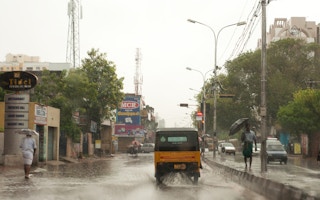Asia is home to more of the fastest growing cities than anywhere else in the world. While this brings opportunities for economic growth, the expansion of Asian cities’ footprints and populations is resulting in intensified pressure on already stressed drinking water supplies. Urbanisation also further decreases the ability of the land to soak up the water and recharge groundwater supplies. As a result, extreme rainfall often causes dangerous and disruptive flooding instead of topping up depleted water supplies.
New report out on global city climate action
The Cities100 report, released on Oct 2, features 100 leading projects from cities around the world that are taking climate action while improving their liveability. The report is the result of a collaboration between the network for megacities, C40 Cities, and the consultancy Nordic Sustainability. The report is funded by Danish philanthropic association Realdania. The 100 city projects represent 12 different sectors within climate action and demonstrate how cities around the world are taking matters into their own hands to solve the climate crisis.
From the report, three cities from Asia have been facing considerable climate hazards, threatening the livelihoods of their citizens. In the face of such challenges, the cities—Chennai, Delhi and Zhenjiang—are initiating efforts to improve their water security and boost their resilience for an uncertain future.
How Chennai future-proofs in the midst of crisis
In 2018, India was “suffering from the worst water crisis in its history, and millions of lives and livelihoods are under threat”. In the coastal city of Chennai, the population jumped from 500,000 to more than 10 million within a hundred years. In addition, large-scale urbanisation and increasing water consumption has exacerbated water scarcity in Chennai. Over the past 20 years, unplanned urbanisation has led to both paving over of green spaces, and significant loss of marshlands. These problems, compounded, mean that while droughts feature in Chennai’s news headlines now, just a few years earlier, the main issue was flooding, as in 2015 when a 100-year rainfall event caused tragic loss of lives and destruction of property valued at US$20 billion.
To tackle the extremely difficult situation, Chennai set out to rapidly restore its water bodies. The 2015 flooding spurred the creation of the Chennai Water Restoration and Resilience Framework, which will speed up the restoration of water bodies that serve to prevent future flooding and recharge aquifers.
One of the elements of the project is transforming dumps into public spaces, future-proof from flooding and droughts, with the added co-benefits of providing green and clean public spaces. The city estimates yearly savings of 420,000 kg of CO2e emissions from the restored landfill sites. Not only is the city benefitting from reduced carbon emissions and rehabilitated water bodies to ensure water security for the future, the investment is also paying off monetarily. While the restoration requires an estimated US$15 million in investment, in only two years, the city will likely see a return on investment through a reduction in damages.
Delhi invests in a water-secure future
As in Chennai, flooding is an equally looming threat in Delhi. In August 2019, the Yamuna river flooded past the danger mark leading to the evacuation of over 10,000 people and resulting in a city-wide flood alert issued for Delhi. The city also struggles with chronic water shortages, which has led to a reliance on ‘water mafia’, a blackmarket for private water tankers.
To further complicate Delhi’s water challenges, the city is growing so rapidly that it is projected to overtake Tokyo as the world’s largest city by 2030, by which time its population is projected to grow by at least 10 million inhabitants.
In an effort to improve the city’s water insecurity, Delhi’s government has taken a political pledge to provide access to clean drinking water to all its citizens, including those living in the city’s informal settlements. Water is provided at an affordable price, and as a human right, with provision of free lifeline water to households with metered connections.
The city is also investing in improving water management. The improvements include the expansion of the water distribution infrastructure, wastewater treatment, and restoring water bodies to recharge and store groundwater. To make the most out of greywater, Delhi has set up decentralised sewage plants in residential areas to prevent contamination of water bodies with sewage, and provide treated water for non-drinking purposes such as flushing toilets and gardening. Dual water systems will be rolled out across group housing societies, optimising recycled water usage. Finally, the city is promoting citizen-based water management including water conservation, recycling, and rainwater harvesting.
Zhenjiang soaks up rainfall to boost climate resiliency
With the Yangtze River to the north, mountains to the south, and interlaced with smaller rivers, the city of Zhenjiang is becoming increasingly exposed to climate change induced flooding and extreme weather events. These risks are exacerbated due to accelerated urbanisation, and the resulting further loss of permeable surfaces.
To decrease the risk of flooding, Zhenjiang is piloting the Sponge City concept. The Sponge City project is designed to retain and release rainwater while reducing pollutants. It intercepts waste water discharge, purifies rainwater, and protects the health of waterways. Overall, resilience is improved when cities develop with rainwater infiltration in mind. Permeable pavements and naturalised spaces work to not only absorb water but also to recharge groundwater and provide opportunities for grey-water to be re-used during the dry season.
To pay for the Sponge City project, the city has leveraged public private partnerships and raised around US$200 million. The project has a lifespan of 23 years, in which the city will continuously work closely with its established partnerships. The project has a capital fund of approximately US$62 million, with the government owning 30 per cent of the equity share and the private partners owning 70 per cent.
To read all about Chennai, Delhi, and Zhenjiang’s adaptation and water management projects, go to cities100report.com. Here, you can also take a deep-dive into the new interactive analysis based on experiences from cities around the world.
Pernille Jægerfelt Mouritsen is project manager and editor of Cities100, while Michelle Gordon is an associate consultant at Nordic Sustainability.


















